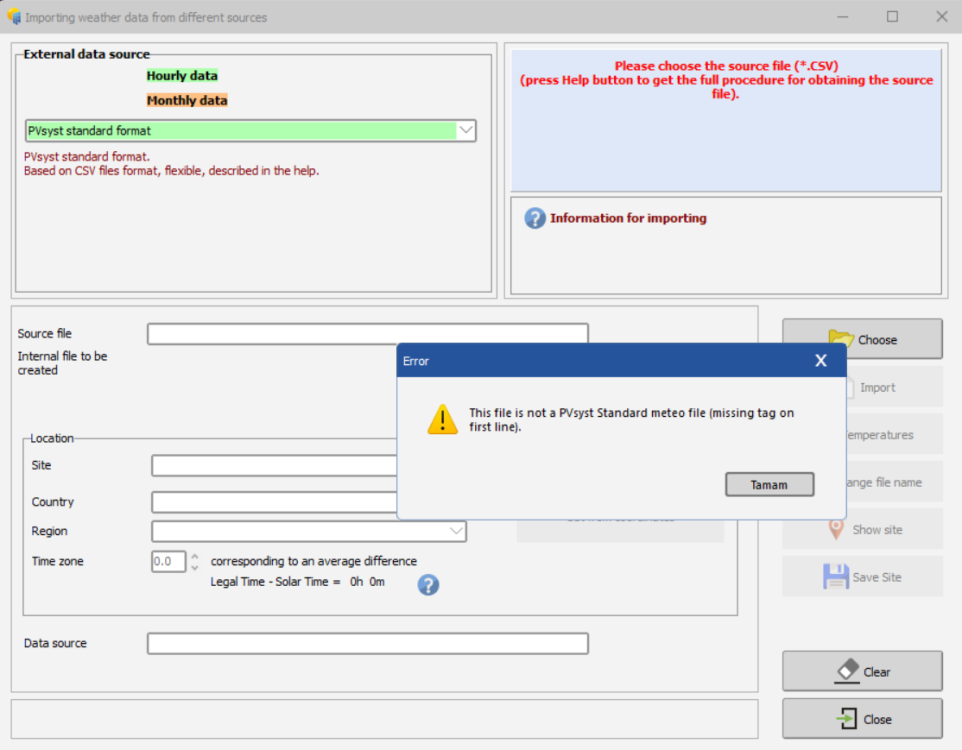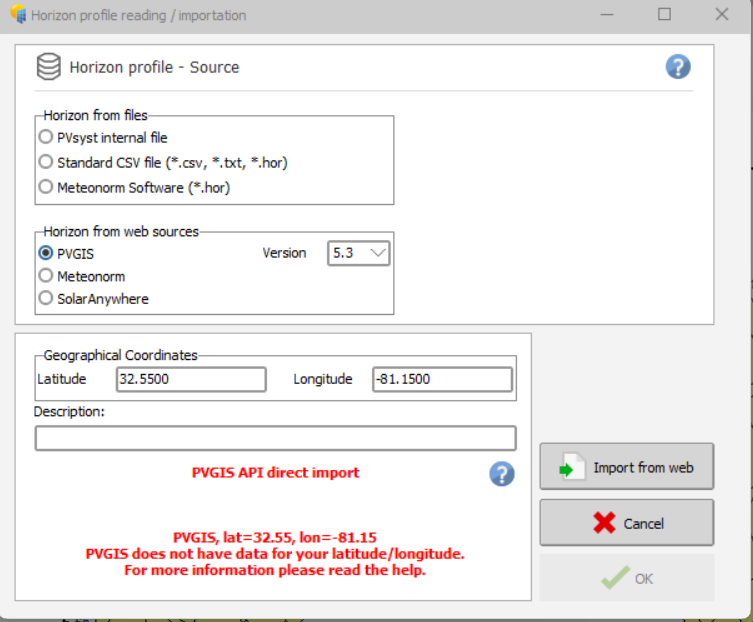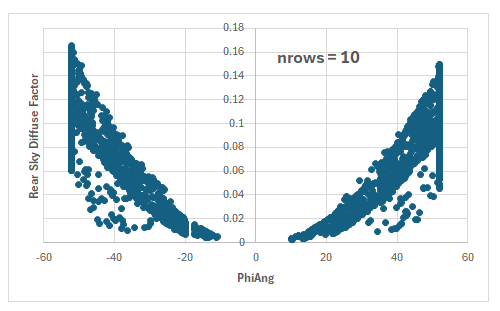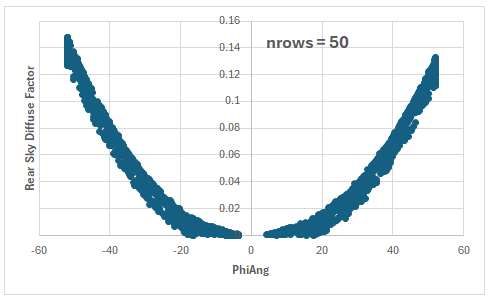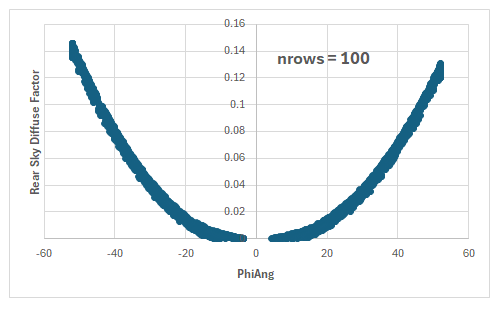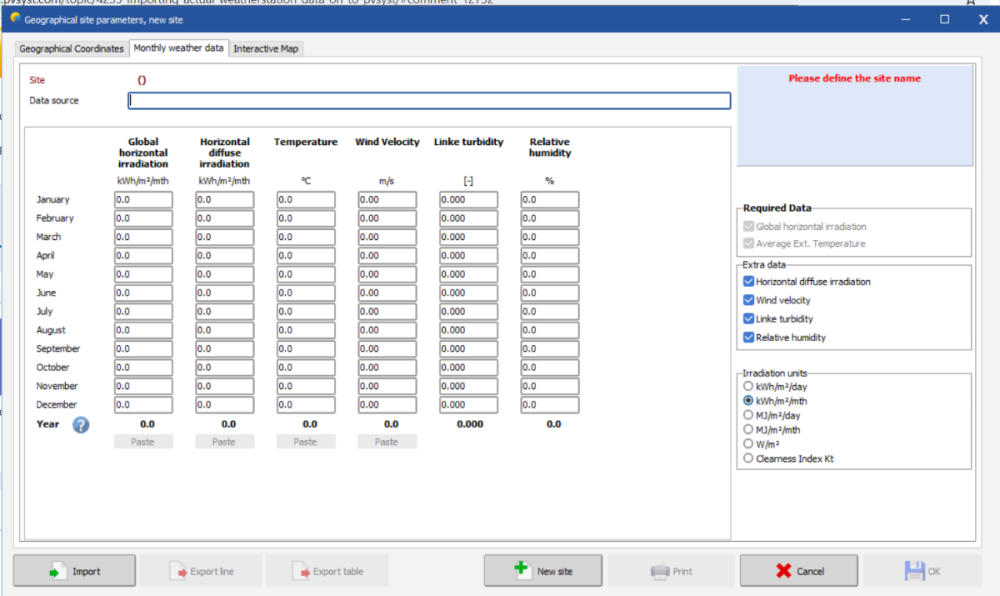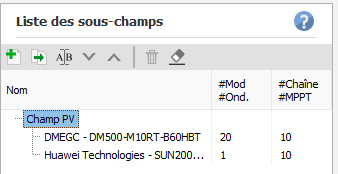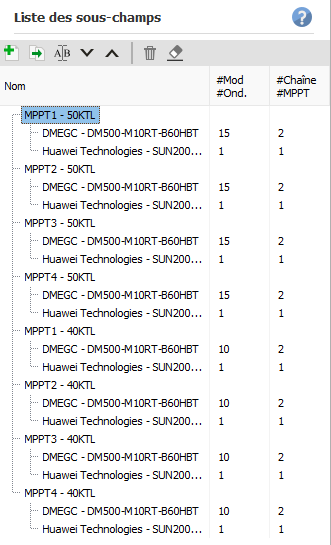All Activity
- Today
-
dtarin started following FOXESS-H3-Pro-20.0
-
OND files are for inverters. It is typical to receive from manufacturer if it is not listed in database already.
-
Qasem Alsalahi joined the community
-
Yes, this is an error in the report. This represents indeed the loss at the output MV line of the Transformer. We will correct this for the next version. When defining the wiring losses in PVsyst, the frame "Array wire loss inverter to transfo" concerns the connexions from the inverter to the transformers, and "Medium Voltage Line" the output of one transformer. The evaluation of the wiring loss is indeed a direct calculation of the loss, at each hour, according to the specified wire resistance and the instantaneous current. There is no uncertainty here, as far as the resistance is well defined. When specified as a percentage at a given power, the resistance is directly calculated from this loss (no error). The only uncertainty could be the resistivity variation according to the wire temperature: in PVsyst this is defined for 50°C, the variability being 0.39 %/°C.
-
Hello PVsyst Community, I am trying to import 10 years (e.g., 2014-2023) of hourly weather data (originally from Open-Meteo) into PVsyst as a single file, specifically using the Databases -> Import weather data -> PVsyst standard format tool. My goal is to have the full 10-year dataset available for PVsys's internal TMY generation. I am using PVsyst version 8.0 Following the detailed documentation (Help -> Importing weather data -> PVsyst standard format), I generated a single multi-year CSV file adhering strictly to the specification: First Line: The file starts exactly with #Weather data hourly data. Metadata Headers: Includes all mandatory #Tag;Value headers using semicolon separators. Data Headers: Includes the two required data header lines (first: Year;Month;Day;Hour;Minute;GHI;DHI;Tamb;WindVel;RelHum, second: ;;;;;W/m2;W/m2;deg.C;m/s;%). Data Format: Data rows use semicolon separators and dot (.) decimal characters. Encoding: Saved as UTF-8 without BOM. File Verification: The generated CSV file looks correctly formatted when viewed in Notepad, matching the requirements described in the Help file (See Image 1 - showing headers and first data rows). When I attempt to import this carefully formatted 10-year file using Databases -> Import weather data -> PVsyst standard format, I immediately receive the error: "This file is not a PVsyst Standard meteo file (missing tag on first line)." (See Image 2). This error occurs despite the first line being exactly what the documentation specifies and appearing correctly in the file itself. Has anyone successfully imported a multi-year hourly data file using the "PVsyst standard format" importer in PVsyst V8.0? Is there a known issue with this importer failing to recognize the #Weather data hourly data tag? Any insights on how to successfully import a multi-year file using the "PVsyst standard format" tool in V8.0 would be greatly appreciated. Thank you. İmage 1 İmage 2
-
CanberkTunay joined the community
-
PVsyst Aging _ Clarification on Degradation Calculation in PVsyst
Kanagavel K replied to Kanagavel K's topic in Simulations
Hi LauraH, Thanks for your explanation. - Yesterday
-
Hi Linda, I think, Nominal ac power should be: 0.85*140KVA= 119KVA and Maximum ac power: 140KVA in main parameter window. Regarding the no. of PCS, we can increase the pcs no. as I confirmed with the utility. The PCS only give 119kW at 0.85 pf.
- Last week
-
Deepak Pandey joined the community
-
Iqra Tahir joined the community
-
Can i get the pan file of FOXESS-H3-Pro-20.0 inverter for my PVsyst?
-
Haseeb joined the community
-
MeerH joined the community
-
JMC started following Data Import from Web not working
-
These two import windows aren't working. Maybe there are others, I've only tried these two. PVSyst 8.0.9. I have tried clicking the other button options and used the map to select a U.S. Coordinate as shown. Is there a setting i've turned off by accident?
-
Thomasfar joined the community
-
"Imp RMS dispersion are not comparable to a degradation factor. You should first translate into a degradation of the Pmpp. This is done stochastically by PVsyst". sorry, I still feel very confused for this topic. Can you clearly tell users how to operate and take values of Imp RMS dispersion ? Should we take 0.4% by default or other values for Topcon or HJT /IBC different solar modules?Or is there any relevant basis to support filling in this data. thanks!
-
Dear Eric, 50k polygons are really too few for large power plants on complex terrain. We also often work on 100MW+ projects and it would be a life-saver if the terrain polygon number would not influence the speed of the software as a whole. Is there really nothing that can be done for this? We have software that can do real-time rendering of millions of polygons... Please consider this, best regards
-
@Michele Oliosi Thanks for the response. I'd like to also add some observations about how this factor changes with number of rows. The fewer rows there are, the more "scattered" the factor is for both negative and positive PhiAng. See below some graphs generated in PVsyst 7.4.8. Though these were generated in v7, the scattering is also observing in v8. I'd like to know what's causing the scattering and if this is intentional.
-
aortuso started following Multiple .pvc file import in the same project
-
Good afternoon, I am working for a client on a PV project which is composed by several plot. My client provided one .pvc file per each plot of the project. When I upload the different files, PVsyst automatically places the perimeter in the centre of the coordinates, overlapping it with the previous one. Is it possible to upload all the .pvc files in the same 3D scene, respecting thier relative position? Or is it better to merge all the files and then upload one single (complete) .pvc files? Thanks in advance
-
aortuso joined the community
-
Dear Nikoloz, We recommend using a maximum of 50k polygons for the ground data. Exceeding this number will make PVsyst slower without significantly improving the accuracy of the simulation results. The import ground as CSV provided by PVsyst has an option to simply the geometry to meet with the 50K limit, you can either use this tool or find a way to reduce the number of polygons in your 3DS file. Regards
-
Michele Oliosi started following Different results between Simulation and batch simulation
-

Different results between Simulation and batch simulation
Michele Oliosi replied to nicolasrata's topic in Problems / Bugs
@nicolasrata indeed I think you have answered correctly here. -
Hi @smeredith sorry for the late response, and thanks for reviving this thread. I have made a ticket we will be looking into this possible issue soon.
-
Why do you divide by two ? I am not sure I am following. No, Imp RMS dispersion are not comparable to a degradation factor. You should first translate into a degradation of the Pmpp. This is done stochastically by PVsyst. The following is really important remark. In PVsyst we consider that the warranty is not equal to the actual degradation ! Therefore what you enter under "Module warranty" has no impact on the simulation. If you want to model the unrealistic scenario in which modules age according to the warranty, then my advice is the following. Simply enter 0.35% per year as average degradation factor, 0% for both RMS dispersions, and put 1% in LID loss (in the tab "Module quality - LID - Mismatch") (almost the same as you did in the screenshot). The lower warranty on the first year is often times due to the LID.
-

Importing actual weatherstation data on to PVsyst
Linda Thoren replied to Sydwell's topic in Meteo data
Hello Kadi1, Indeed the simulation will be done for maximum a year, thus the weather data can not contain data for more than a year. The simulation will be done with hourly time steps, so to use the custom file you need to have hourly values. Do you have daily averages? You could possibly create monthly averages based on all the years of data that you avail, and create a synthetic data file based on the monthly averages. This can be done but creating a new site and fill in the Monthly weather data: -
Suryakant Dixit joined the community
-
Kadi1 started following Importing actual weatherstation data on to PVsyst
-
Hello, i have similar question In my data i have all avg temperature and GHI from 2022 to 2024 i noticed that i can only import one year my second question is in my data the cell of date only have MM/DD/YYYY i dont have the hours and minutes can i do that conversion without them ?
-
Kadi1 joined the community
-
Nevermind. I figured out the problem.
-
I'm trying to load a project I recently ran in v.7 into v.8. I follow the usual procedure: Click on "Import project," then select the project's zip file, as exported. A new window comes up that tells me to "Please choose a zip file containing projects." Why would I have a zip file containing projects inside a project zip file? Do I need to zip the zip file? This makes no sense and doesn't conform to the old procedure. Using 8.0.9. Thanks, Laura
-
I don't think that fully answers the question. Swonno is saying that projects that s/he already worked on in v. 8 don't show up in the list on v. 8. Why should this be? Thanks, Laura
-
Different results between Simulation and batch simulation
nicolasrata replied to nicolasrata's topic in Problems / Bugs
Ok, after doing some trial and error I can answer to myself. Difference between module quality values. The default value in detailled loss is shown at -0.7 but might be round at -0.8 in the results. Need to change it manually to-0.7. Do batch simulation work with multiple inverters ? Yes but you cant make change on the chain or inverter in the params file because it will apply to all the inverters. Is it normal to have variation between batch simulation and manual simulation ? If the parameters are correct there is no variation. -
Resurrecting this thread since I've noticed the same thing happening in PVsyst v8. The main difference between v7 and v8 seems to be that circumsolar is separated from the rear sky diffuse in v8, regardless of whether the user chooses the setting that separates it from the diffuse or includes it.
-
No..... CSV file is not a solution it took an ugly terran. I have converted obj file to 3ds fil , which was 7 MB in size , imported it to 3d shading scene as a groung data but there is another big problem PVsyst is not situable to work with high quality objects (the 3d terran what PVsyst imports by default those maps are too old) and it stucked , frezzed and didnot respond.we are working with huge landskape about 1.4 square kilometers . This is a serious problem when your customers are working on big farms like 150-200 MW and if PVsyst freezes all the time
-
Hi, I'm planning to do a batch simulation to test a setup in different cities. Before that I did a test with a batch of only 2 variants to check the results against a manual simulation for each of the variant. The 2 variants : Same plane, same orientation, same modules, same parameters One variant with a 100KTL One variant with a 50+40KTL 100KTL 50+40KTL The losses in the batch params are the same as the ones in the detailed loss. Do you have an idea about the following things : Why is there a difference between the module quality for the 100KTL variant ? Do batch simulation work with multiple inverters ? Is it normal to have variation between batch simulation and manual simulation ? Thank you



